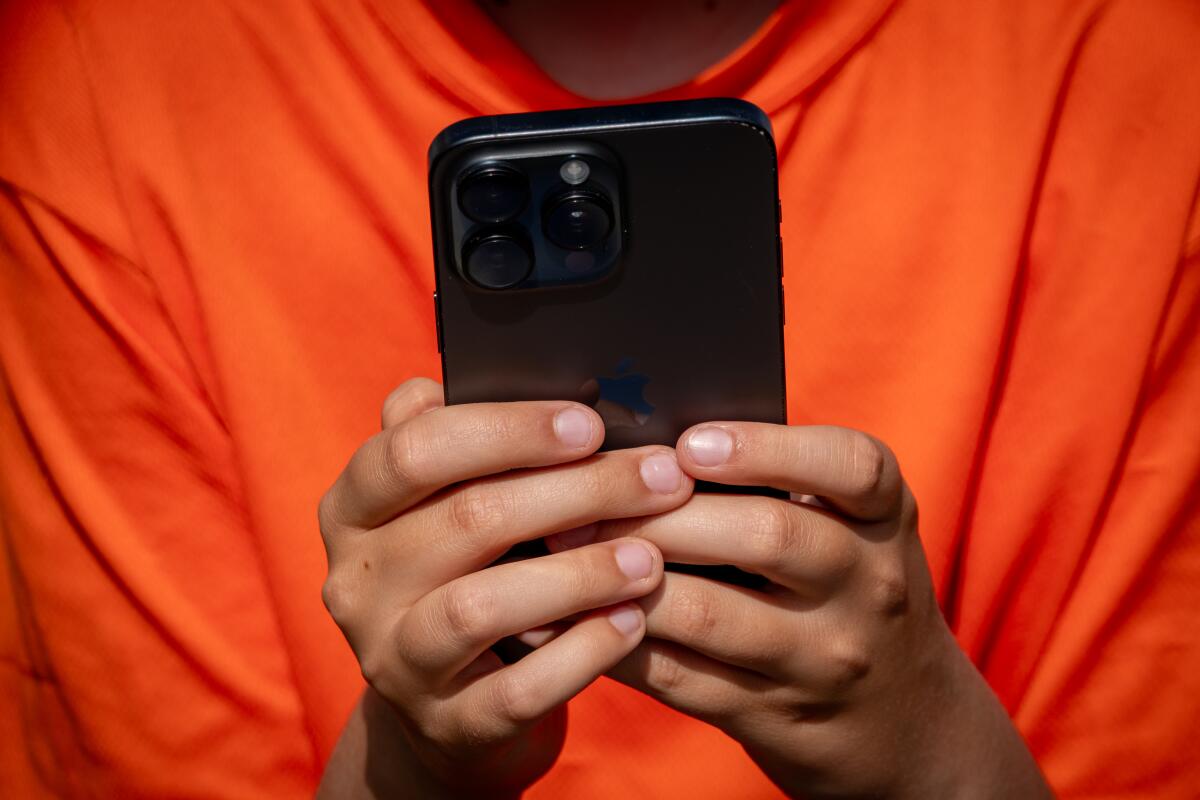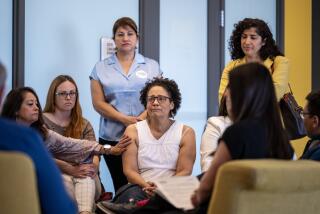More Californians now get therapy via a video screen or phone than through in-person sessions

- Share via
More Californians are talking to their therapists through a video screen or by phone than in person, marking a profound shift in how mental healthcare is delivered as record-setting numbers seek help.
While patients and providers say teletherapy is effective and easier to get than in-person services, experts in the field noted that teletherapy often requires a skilled mental health practitioner trained to pick up subtle communication cues.
Almost half of the roughly 4.8 million adults who visited a medical professional for mental health or substance use disorders in 2023 did so exclusively through teletherapy, according to a KFF Health News analysis of the latest data from UCLA’s California Health Interview Survey.
About 24% of adults used a combination of face-to-face and teletherapy in 2023, while roughly 23% got help exclusively in person, according to the survey of about 20,000 California households.
A recent national study of patients in the Department of Veterans Affairs healthcare system found a similar pattern: Fifty-five percent of mental healthcare continued to be provided via telemedicine, a figure that jumped after patients shifted to teletherapy by necessity during the COVID-19 pandemic.
Teletherapy is certainly more convenient, enabling patients to see their therapists from the comfort of home.
“It’s actually really effective,” said Joshua Heitzmann, president of the California Psychological Assn. “I think part of that is that it just allows more comfortability — people are willing to work a little bit more when they’re comfortable.”
Studies back that up: Teletherapy patients report getting better at rates similar to those receiving in-person therapy.
“Research has basically shown that there’s no difference between teletherapy versus in-person therapy — so, basically, as effective as in-person therapy,” said Tao Lin, a researcher at the University of Pennsylvania’s Center for the Treatment and Study of Anxiety, who recently conducted an analysis of several studies comparing teletherapy and face-to-face therapy.
But Lin said it can be difficult for a therapist to see hand motions or read body language during a video call, which could lead to therapists missing nonverbal cues about their patients’ emotional states. Lin’s most recent research, yet to be published, suggests therapy over the telephone “is less effective than video conferences” due to “more loss of information.”
And some people have trouble emotionally connecting with a therapist without seeing them in person, Lin said. Technical difficulties, not uncommon, can also interfere with clients building a therapeutic relationship.
Sacramento resident David Bain relies on teletherapy to treat his depression because mobility issues make it difficult for him to visit a therapist in person.
“It’s almost to the point where I wouldn’t be able to get the service if I wasn’t able to get it through telehealth,” said Bain, executive director of NAMI Sacramento, a nonprofit that provides support and advocacy to people with mental illness.
Bain said that his one-on-one teletherapy sessions have helped, but that he’s had less success with online group therapy. He recently participated in a 10-week dialectical behavior therapy class, but he didn’t get the connection and support he received in past in-person group settings, he said.
“There was probably me and two or three other people that were actually showing ourselves on screen,” he said. “Everyone else had their screens off.”
Teletherapy is increasingly offered through cellphone applications such as BetterHelp and Talkspace. Patients using these applications often pay a subscription fee, which insurance may partly cover, for regular sessions and contact with therapists.
Eunkyung Jo, a researcher at the UC Irvine, co-wrote a study published in 2023 that looked at patient reviews of eight of the most popular teletherapy apps. Many patients expressed satisfaction with their therapists, but the team also uncovered negative patterns.
Some patients did not get the therapy they paid for, often because of technical difficulties. Other patients reported their therapists acted disinterested or unprofessional, a finding Jo said could be tied to the relatively low pay therapists earn on some apps.
And several users mentioned in reviews that their therapist suddenly disappeared from the app without explanation. She said therapists in more traditional “pay-as-you-go” arrangements rarely discontinue treatment without warning.
Nikole Benders-Hadi, chief medical officer of Talkspace, said patients often can use their insurance to get therapy on the platform, at a typical cost of a $10 copay. Separately, Talkspace spokesperson Jeannine Feyen said that salary for therapists has increased since Jo’s study was conducted, and that full-time Talkspace therapists make $65,000 to $90,000 a year.
At BetterHelp, therapists earn up to $91,000 and the average patient rating last year for a live session on the platform was 4.9 out of 5, spokesperson Megan Garner said. A significant majority of patients reported reliable symptom improvement or remission, she said.
The number of Californians visiting a medical professional for mental health issues rose by about 434,000, or 10%, from 2019 to 2023, UCLA data show. It jumped by nearly 2 million, or 69%, from 2009 through 2023.
Even so, the transition from in-person therapy to teletherapy has left some behind.
The UCLA data show that Californians living within 200% of the federal poverty level — for example, a family of four with a household income of about $60,000 or under in 2023 — were less likely to use teletherapy.
The data also show that residents in rural areas, where access to telehealth should provide a boon, weren’t using it as much as residents of urban areas.
For example, about 81% of San Francisco Bay Area residents who visited a medical professional for mental healthcare in 2023 did so either fully or partially via teletherapy. About 62% of residents in the state’s rural, mountainous counties did the same.
Those disparities are suggestive of gaps seen in remote-work patterns: Wealthier, urban Californians are more likely to work from home than lower-income, rural residents. By extension, Californians of greater means have more opportunities to arrange online appointments and may be more comfortable with them.
By comparison, low-income folks tend to go into the office for doctor visits, Heitzmann said.
Lower-income and rural Californians may also lack the reliable internet service necessary for good telehealth. A recent KFF Health News analysis found millions of Americans live in places with doctor shortages and poor internet access.
Lower-income Californians also are more likely to live in tight quarters, making privacy for an intimate therapy session difficult.
Regardless, teletherapy is now dominant. And it’s not just patients who enjoy the convenience. Many therapists have ditched expensive office rents to work from home.
“COVID allowed that,” Heitzmann said. “A lot of folks really just got rid of their offices and were perfectly happy converting their home into some kind of office and doing it all day long.”
This article was produced by KFF Health News, a national newsroom that produces in-depth journalism about health issues.
More to Read
Sign up for Essential California
The most important California stories and recommendations in your inbox every morning.
You may occasionally receive promotional content from the Los Angeles Times.










